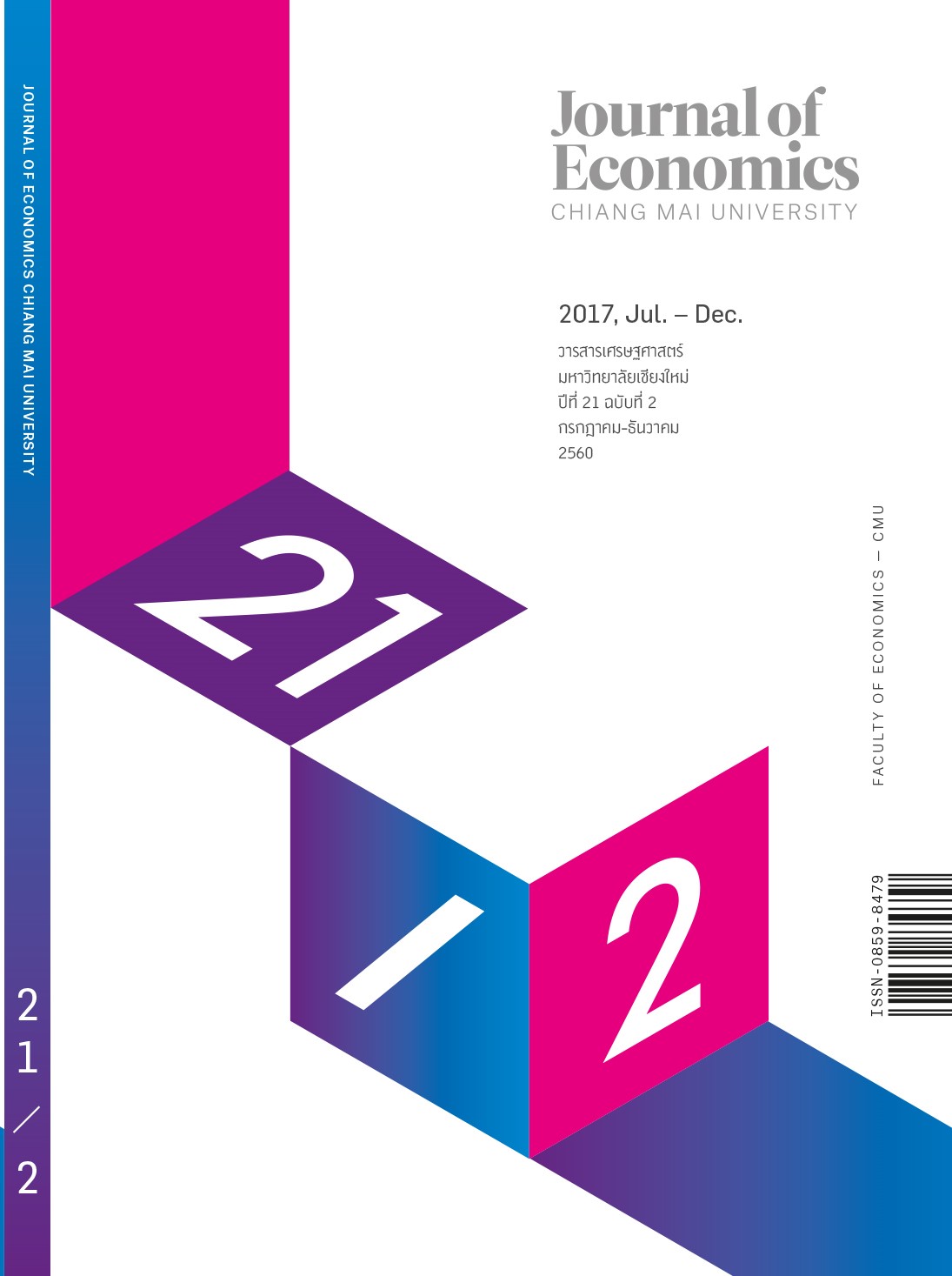การแบ่งบัญชีในใจ การควบคุมตัวเอง การหลีกเลี่ยงความเสี่ยง และการออมของบุคคล
Mental Accounts, Self-control, Risk Aversion and Saving
Keywords:
saving, mental account, self-control, risk averse, การออม, การแบ่งบัญชีในใจ, การควบคุมตนเอง, การหลีกเลี่ยงความเสี่ยงAbstract
Abstract
Thailand is facing big challenges from its imminent shift into a full-fledged ageing society. The elderly dependency ratio has increased from 20% in 2010 to 60% in 2040 (NESDB, 2013). From household survey in 2010, NESDB (2014) found that only 4% of elderly people spent their saving for daily expenses. The important policy question is how to encourage people to save money when they are still able to work. Therefore, the main objective of this study is to determine the socio-economic factors and behavioral factors that influence the saving behavior.
The samples of this study are government officials and government servants who are working in a local government unit in Nakorn Pathom province by using questionnaire (Face-to-face interviews). The results show that most samples (80%) have saving and average household saving is about 8,920 baht per month. Interesting, several behavioral factors influence saving amount of household such as mental account, self-control, and risk preference. Individuals who applied mental accounting concept with their savings were likely to have more saving, whereas individuals who had less self-control were likely to have less saving. The ones who were risk averse were likely to have more saving. Therefore, we can encourage people to save more by separating their money into separate accounts based on a variety of subjective criteriaTo do this, it would help to grow the saving effortlessly.
Keywords: saving, mental account, self-control, risk averse
JEL Classification Codes: A12, D01, D90
บทคัดย่อ
ประเทศไทยกำลังเผชิญกับความท้าทายที่สำคัญที่การเปลี่ยนแปลงโครงสร้างประชากร ส่งผลให้ประเทศไทยจะกลายเป็นสังคมผู้สูงอายุขั้นสูงสุดในไม่ช้า โดยอัตราการพึ่งพิงของผู้สูงอายุต่อประชากรวัยทำงานได้ จะเพิ่มขึ้นจากร้อยละ 20 ในปี 2553 เป็นร้อยละ 60 ในปี 2583 (สำนักงานคณะกรรมการพัฒนาการเศรษฐกิจและสังคมแห่งชาติ: สศช., 2556) และจากการสำรวจในปี 2557 พบว่า มีผู้สูงอายุเพียงร้อยละ 4 เท่านั้นที่ใช้เงินออมของตนเองเป็นรายได้หลักในการดำรงชีพ (สศช., 2557) จึงเป็นคำถามที่สำคัญในเชิงนโยบายว่าเราจะส่งเสริมให้คนเริ่มออมตั้งแต่ในวัยทำงานได้อย่างไร ดังนั้นงานศึกษานี้จึงมีวัตถุประสงค์เพื่อหาปัจจัยทั้งที่เป็นปัจจัยส่วนบุคคล และปัจจัยด้านพฤติกรรมว่าจะส่งผลอย่างไรต่อการออมของบุคคล
ในการศึกษานี้ใช้กลุ่มตัวอย่างของกลุ่มข้าราชการส่วนภูมิภาคในจังหวัดนครปฐมจำนวน 100 รายโดยการสัมภาษณ์แบบเผชิญหน้า ผลการศึกษา พบว่า คนส่วนใหญ่มีเงินออม (ร้อยละ 80) โดยมีเงินออมเฉลี่ยของครัวเรือนมีค่าเท่ากับ 8,920 บาทต่อเดือน สิ่งที่น่าสนใจของการศึกษานี้คือ ปัจจัยทางพฤติกรรมในหลายปัจจัยส่งผลต่อการออมอย่างมีนัยสำคัญ ได้แก่ การออมเงินแบบแบ่งบัญชีในใจส่งผลทำให้มีเงินออมเพิ่มขึ้น ขณะที่คนที่มีลักษณะที่ไม่สามารถควบคุมตนเองได้ส่งผลให้มีเงินออมลดลง และคนที่มีพฤติกรรมการหลีกเลี่ยงความเสี่ยงมีแนวโน้มที่จะมีเงินออมมากกว่าคนที่ชอบเสี่ยงหรือคนที่มีความเป็นกลางทางความเสี่ยง ดังนั้น วิธีการหนึ่งที่จะส่งเสริมให้คนออมมากขึ้น สามารถทำได้โดยการส่งเสริมให้ออมเงินด้วยการแยกเงินออมออกเป็นส่วนๆ ตามวัตถุประสงค์ของการออม โดยไม่ให้มีการนำเงินต่างวัตถุประสงค์มาใช้ร่วมกัน น่าจะส่งเสริมให้บุคคลสามารถออมเงินได้เพิ่มขึ้น
คำสำคัญ: การออม การแบ่งบัญชีในใจ การควบคุมตนเอง การหลีกเลี่ยงความเสี่ยง
JEL Classification Codes: A12, D01, D90
References
Beverly, S. G., & Sherraden, M. (1999). Institutional determinants of saving: Implications for low-income households and public policy. Journal of Socio-Economics. 28(2), 457 – 473.
Bureau of Savings and Investment Policy. (2015). GDI GDS and Gap Savings - Investment to GDP at Current Prices. Retrieved from http://www.fpo.go.th/ (in Thai).
Fiscal Policy Office. (2015). Savings and Investment. Retrieved from http://www.fpo.go.th/ (in Thai).
Geen, R. G. (1995). Human Motivation: A Social Psychological Approach. California: Wadsworth, Inc.
Greene, W. H. (2003). Econometric Analysis. New Jersey: Edition. Pearson Education, Inc.
Jicharoen, W. (2015). Microeconomics 2. Bangkok: Ramkhamhaeng University. (in Thai).
Jong-Youn Rha. (2006). The Effect of Self-Control Mechanisms on Household Saving Behavior. Financial Counseling and Planning, 17(2), 3-16.
Lerdsongkram, K. (2012). Saving Behavior and Factors Affecting Saving in Real Estate Company. Master’s Project M.Econ (Economics of Human Development), Srinakharinwirot University. Bangkok. (in Thai).
National Statistical Office. (2015). Income, expenses and monthly savings of Thai households. Retrieved from http://www.nso.go.th/. (in Thai).
Office of the National Economic and Social Development Board. (2013). Database of social and quality of life. Retrieved from http://social.nesdb.go.th/social/ (in Thai).
Office of the National Economic and Social Development Board. (2014). Thai society in the first quarter of 2014. Social Situation and Outlook, 11(2), 147-154. (in Thai).
Sirisarakul, D. (2011). Factors Affiecting the Saving of Banks’ Employee in Mueang District, Lampang Province. Independent Study Submitted in Master of Economics, Chiang Mai University. Chiang Mai. (in Thai).
Sombatwattana, P. (2011). Causal model of Controlling Saving Behavior of Early-EstablishmentStage Persons in Metropolitan Area. Doctor of Philosophy (Ph.D.), Srinakharinwirot University. Bangkok. (in Thai).
Sombatwattana, P. (2011). Mental Accounting in Personal Finance of Social Sciences and Behavioral Science Graduate Students, Srinakharinwirot University. Doctor of Philosophy (Ph.D.), Srinakharinwirot University. Bangkok. (in Thai).
Soonteeprasit, J. (2016). Professional risk management. Retrieved from
https://chirapon.wordpress.com. (in Thai).
Srisawalak, O. (2016). Behavioral Economics. Retrieved from http://www .stou.ac.th/stouonline/lom/data/sec/Alternative/03-02-05.html. (in Thai).
Tangtiwaporn, K. (2012). Factors Affecting Saving Behavior of Working People: A Case Study of Bank Employees. Master’s thesis. M.B.A. (Marketing), Srinakharinwirot University. Bangkok. (in Thai).
Thaler, Richard H. (1999). Mental Accounting Matters. Journal of Behavioral Decision Making, 12, 183-206.
Thaler, R. H. (2016). Misbehaving: The Making of Behavioural Economics. UK: Penguin Random House.
Thaler, R. H. & Benartzi, S. (2004). Save more tomorrow: Using behavioral economics to increase employee saving. Journal of Political Economy. 112(1), 164-187.
Downloads
Published
Issue
Section
License
All opinions and contents in the CMJE are the responsibility of the author(s). Chiang Mai University Journal of Economics reserves the copyright for all published materials. Papers may not be reproduced in any form without the written permission from Chiang Mai University Journal of Economics.
ข้อคิดเห็นที่ปรากฏและแสดงในเนื้อหาบทความต่างๆในวารสารเศรษฐศาสตร์มหาวิทยาลัยเชียงใหม่ ถือเป็นความเห็นและความรับผิดชอบโดยตรงของผู้เขียนบทความนั้นๆ มิใช่เป็นความเห็นและความรับผิดชอบใดๆของวารสารเศรษฐศาสตร์ มหาวิทยาลัยเชียงใหม่
บทความ เนื้อหา และข้อมูล ฯลฯ ในวารสารเศรษฐศาสตร์มหาวิทยาลัยเชียงใหม่ ถือเป็นลิขสิทธิ์เฉพาะของคณะเศรษฐศาสตร์มหาวิทยาลัยเชียงใหม่ หากบุคคลหรือหน่วยงานใดต้องการนำทั้งหมดหรือส่วนหนึ่งส่วนใดไปเผยแพร่ต่อหรือเพื่อกระทำการใดๆ จะต้องได้รับอนุญาตเป็นลายลักษณ์อักษร จากวารสารเศรษฐศาสตร์ มหาวิทยาลัยเชียงใหม่





